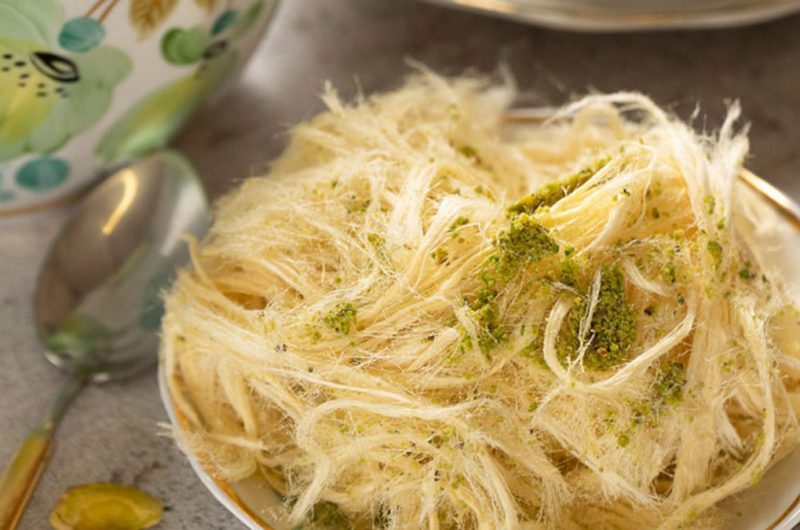© All Rights Reserved.
Pashmak recipe | Persian cotton candy or fairy floss, amazing and delicious soft Iranian sweet in 5 steps
Pashmak is a sweet and delicious junk food with many fans and is one of the ancient Iranian sweets used in some religious ceremonies and happy rituals.
Pashmak is obtained using simple materials, and its texture is in the form of thin strings and fibers in pink, white, yellow, brown, etc., colors that melt in the mouth quickly.
We are adding the essential oils of fruits, coffee, cocoa, and saffron to the sugar used in the production of pashmak,By adding colored materials to white cotton candies, colored or colorful pashmak is produced.
In the past, most of these threads were wrapped around a piece of wood, but today, wool is wrapped in various ways. This delicious sweet also benefits the body, and in this article in the Cookery Magazine, we will introduce you to the properties of cotton candy.
Ingredients for making proper Pashmak for yalda night
| Flour | 2.5 cup |
| Sugar | 2.5 cup |
| Water | 1 cup |
| Lemon juice | A teaspoon |
| Cardamom powder | ½ a teaspoon |
| Butter | 1 tablespoon |
⭐️ You can use vanilla instead of cardamom.
⭐️ Instead of butter, you can use liquid oil or do not add anything at all.
⭐️ If you want your pashmak to be saffron or colored, add a few drops of jelly food coloring or thick brewed saffron to the nectar.
⭐️ If you want your pashmak to have cocoa flavor, reduce two spoons of flour and add two spoons of cocoa powder after the flour is roasted.
Recipe for making Pashmak
The first step
To make homemade pashmak, first pour two cups of sifted pastry flour into a pan and fry on low heat for 10 minutes until the rawness of the flour is drawn out and its good smell rises.
Add half a teaspoon of cardamom powder and stir, then add a
tablespoon of butter and stir frequently until the butter melts.
⭐️Butter makes the flour a little lumpy, which is fine.
Then we remove the roasted flour from the heat, keep it aside until it cools down, and then sift it into a large round tray.

The second step
To make nectar, pour half a glass of water and a glass of sugar into the pot and stir until the sugar dissolves in the water, then please put it on low heat until the water boils and the nectar thickens.
It takes about 30 minutes on low heat to boil and become thick.
After this time, add a tablespoon of lemon juice to test whether the nectar has reached the required consistency.
We take a tablespoon of nectar and pour it into a bowl of water and collect the nectar with our fingers.
If the nectar hardens in the water and we can remove it with our hands, it is ready; If not, it should be boiled a little longer to be ready.
⭐️If the nectar boils too much, it will harden like a rock when you pour it into the pan. So make sure to remove it on time.
The third step
At this time, we put some pieces of ice in a freezer bag and tied the lid; we greased the bottom of a large pan with butter and then put the greased pan on the ice.
⭐️The pan gets greasy because the nectar does not stick to the pan, and the reason we put ice under it is because the nectar cools down very quickly.
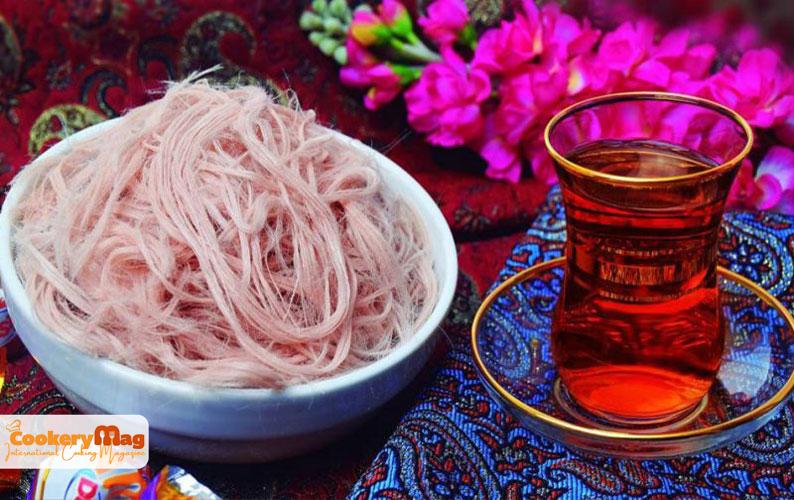
The fourth step
After the nectar is prepared, we pour it into a greased pan, which we put on ice, and with a wooden spoon or spatula, we direct the nectar from around to the center of the pan until it collects in a cool place.
When the nectar is collected in the center of the pan, we take the cooled condensed nectar with our hands and make it into a circle.
The fifth step
We put the rounded nectar in the middle of the flour tray, take a little flour from around the tray, and sprinkle it.
We have to open the rounded nectar with our hands, swing it like an English 8, then fold it on top of each other until it becomes a circle, open again as an 8, and close it until the pashmak is formed.

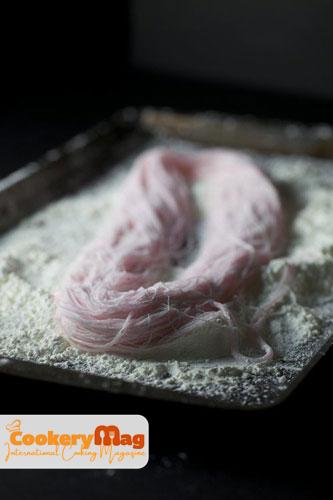

We have to do this about 20 to 30 times.
The more slowly and patiently you spread the nectar into the flour, the thinner the wool fibers.
Be careful not to use scissors to cut the wool until the wool is completely ready because this will cause the wool fibers to stick together and ruin the work.
Our homemade wool is ready so easily. You need to act carefully and patiently. You can serve it the same way or mix it in small molds or in the bottom of a cup to make it a bite.
Types of fairy floss
Cotton candies are sometimes produced using only sugar. The taste of this type of pashmak is not much different from the taste of sugar obtained from it. Wools that are for immediate consumption are more of this type. In another type of wool production, they add other materials such as cocoa, coffee, saffron, cardamom, and food colors and produce the following types of wool.
- Saffron fairy floss
- Vanilla fairy floss
- Pistachio saffron fairy floss
- Orange fairy floss
- Strawberry fairy floss
Pashmak has been memorable for many of us, and we children of yesterday often ate pashmak in parks and enjoyed its sweet taste.
Iranian pashmak is different from the pashmak sold in the Amusement Parks today, and its cooking method is also different. Pashmak is made by passing hot and humid air over sugar.
When the hot air hits the sugar, it becomes semi-solid. After that, due to the continuous flow of hot air coming into contact with the semi-solid sugar crystals and the presence of air humidity, the crystals become long and narrow strands.
For consumption immediately after production, these threads are mostly wrapped around a piece of wet wood, and for other uses, the wool is packaged in various ways.
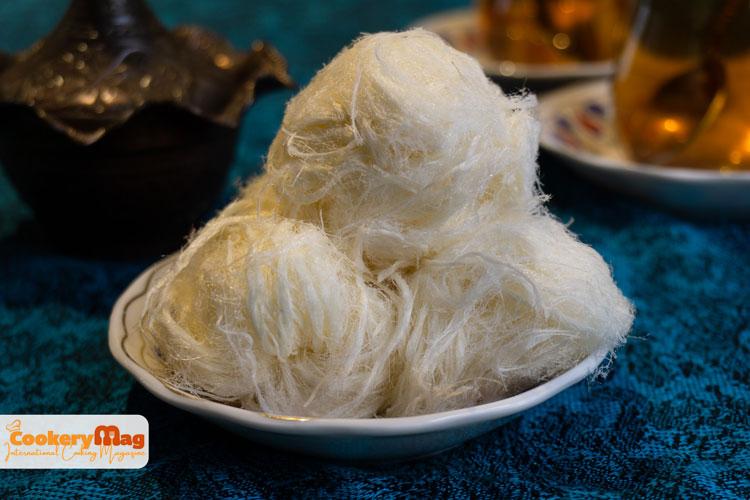
Other ingredients, such as fruit essences, coffee, cocoa, and saffron, are sometimes added to the sugar used to produce wool.
Pashmak is white, but sometimes food colors are added, and colored or colorful pashmaks are produced. Pashmak is also used as an irony in everyday language.
How and in which country in the world was the origin of first fairy floss production?
In some sources, pashmak’s production date is considered to be 19th century, but some people believe that pashmak was created in Italy in the early 15th century.
As mentioned in the historical books, a dentist named William Morris and a confectioner named John C. Wharton invented the cotton candy production machine in 1897.

In 1921, Joseph Lascaux, a dentist from New Orleans in Louisiana, invented a device similar to the pashmak machine and named his invention “Cotton Candy” and “Cotton Fairy.”
An automatic fairy floss machine was built in 1970 to produce and package the product. This construction made producing pashmak easier and made it available to the general public.

Canada’s Tootsie Roll is the world’s largest cotton candy factory that produces fruit-flavored cotton candy. Today, cotton candies are available in different colors, flavors, and packaging, but in the past, most pashmaks were white and wooden.
The most famous fairy floss in the world
American William Morrison and John Watton invented the most famous wool in the world. The two showed their invention to the public at the 1904 World’s Fair, where 68,655 thousand cotton candy bundles were sold.
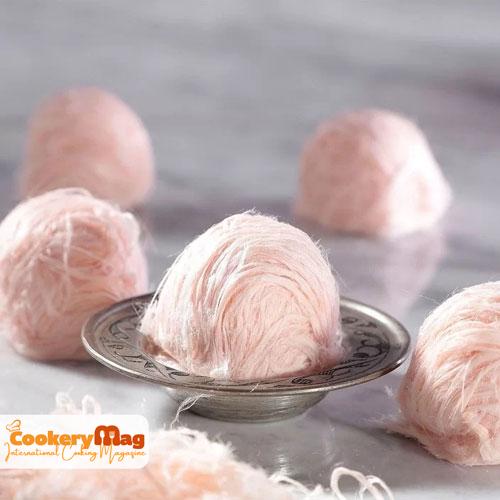
The public welcomed this unveiling, after which different and interesting names were considered for this type of food in various cultures. It was derived either from the construction type or the shape of this type of food.
Today, this junk food is known by different names such as cotton candy (American English), Candy floss (British English), Suikerspin (Dutch), which means sugar spinner, and Pashmak (Persian: Pashm + ak).
When did pashmak arrive in Iran?
The history of using this sweet in Iran is not precisely known, but we can say after the Second World War, pashmak entered Iran, produced for the first time in the city of Borujerd, called pashmineh (پشمینه). There are several workshops producing pashmak in the city of Borujerd.
Still, Persian cotton candy is mentioned in the poems of Abo Eshagh Ata’meh Shirazi, a poet of the 9th century AH, which indicates that this sweet has been among Iranian foods since about six hundred years ago.
میکشد کشکک بچربی هر زمان مشتاق را / می برد پشمک بشیرینی دل عشاق را
The most famous Iranian pashmak is produced in the city of Yazd, the history of which dates back to 1295.
During production and regarding its export, it was used in all parts of the world.
Do we have a National Cotton Candy Day?
December 7th is named National Cotton Candy Day every year in the United States of America. Cotton candy is a bulky junk food that is made from sugar and is white, but by adding colored ingredients to it, colorful cotton candies can be produced.
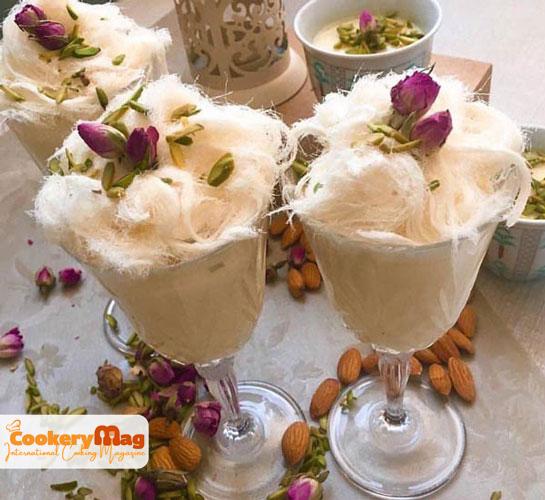
Cotton kandy is made by passing hot and humid air over sugar. When the hot air hits the sugar, the sugar becomes semi-solid. Then, the continuous flow of hot air and humidity causes the semi-solid sugar crystals to become long and narrow strings.
Advantages and disadvantages of Pashmak
One of the unique benefits of pashmak is its soothing properties due to the presence of sugar in its composition, which also increases the brain’s concentration power and helps a lot in healing wounds.
Diarrhea is one of the most common problems among most people, especially diarrhea caused by medicine.
It can be prevented by consuming cotton candy because the flour in it will prevent diarrhea and repair intestinal scratches.
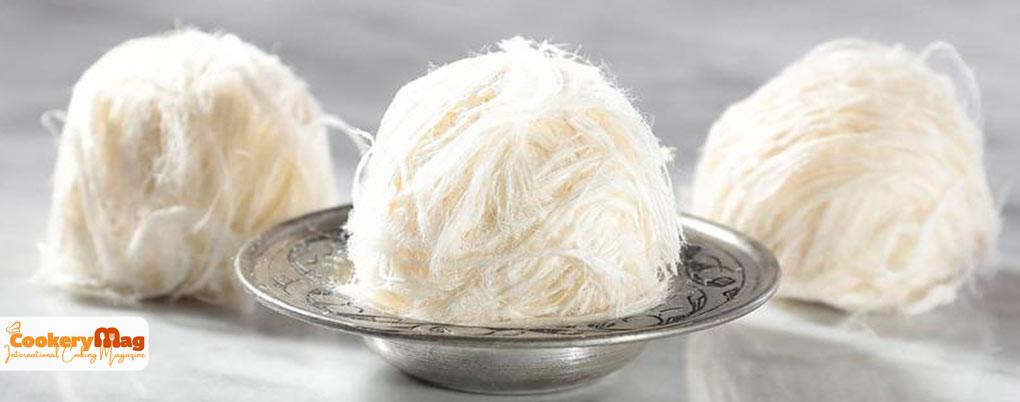
Due to the presence of cardamom, Persian fairy floss strengthens the body and helps a lot to cheer up and create an optimistic mood.
Persian fairy floss has sugar, sodium, calories, fat, and cholesterol. So you can use it as a healthy dessert.
Although pashmak is a delicious food, you should not ignore its disadvantages because cotton candy contains a lot of sugar and is harmful to people with diabetes. Too much sugar increases the risk of heart disease and exposes teeth to decay, so don’t overdo it.
Frequently Asked Questions about Persian fairy floss
How is Persian cotton candy made?
Persian cotton candy is made by heating a mixture of sugar, water, and flavorings, such as rosewater or saffron.
What flavors are commonly found in Persian cotton candy?
While the traditional flavor of pashmak is often rosewater, other flavors such as pistachio, saffron, vanilla, or chocolate are also favored.
Pashmak
Course: SweetCuisine: Persian foodDifficulty: Easy4
servings30
minutes30
minutes0/394
kcalPashmak is an amazing Iranian junk food that served at yalda night with hot drinks especially tea.
Ingredients
Flour, 2.5 cup
Sugar, 2.5 cup
Water, 1 cup
Lemon juice, A teaspoon
Cardamom powder, ½ a teaspoon
Butter, 1 tablespoon
Directions
- The first step
To make homemade pashmak, first pour two cups of sifted pastry flour into a pan and fry on low heat for 10 minutes until the rawness of the flour is drawn out and its good smell rises.
Add half a teaspoon of cardamom powder and stir, then add a
tablespoon of butter and stir frequently until the butter melts.
⭐️Butter makes the flour a little lumpy, which is fine.
Then we remove the roasted flour from the heat, keep it aside until it cools down, and then sift it into a large round tray. - The second step
To make nectar, pour half a glass of water and a glass of sugar into the pot and stir until the sugar dissolves in the water, then please put it on low heat until the water boils and the nectar thickens.
It takes about 30 minutes on low heat to boil and become thick.
After this time, add a tablespoon of lemon juice to test whether the nectar has reached the required consistency.
We take a tablespoon of nectar and pour it into a bowl of water and collect the nectar with our fingers.
If the nectar hardens in the water and we can remove it with our hands, it is ready; If not, it should be boiled a little longer to be ready.
⭐️If the nectar boils too much, it will harden like a rock when you pour it into the pan. So make sure to remove it on time. - The third step
At this time, we put some pieces of ice in a freezer bag and tied the lid; we greased the bottom of a large pan with butter and then put the greased pan on the ice.
⭐️The pan gets greasy because the nectar does not stick to the pan, and the reason we put ice under it is because the nectar cools down very quickly. - The fourth step
After the nectar is prepared, we pour it into a greased pan, which we put on ice, and with a wooden spoon or spatula, we direct the nectar from around to the center of the pan until it collects in a cool place.
When the nectar is collected in the center of the pan, we take the cooled condensed nectar with our hands and make it into a circle. - The fifth step
We put the rounded nectar in the middle of the flour tray, take a little flour from around the tray, and sprinkle it.
We have to open the rounded nectar with our hands, swing it like an English 8, then fold it on top of each other until it becomes a circle, open again as an 8, and close it until the pashmak is formed.
Conclusion
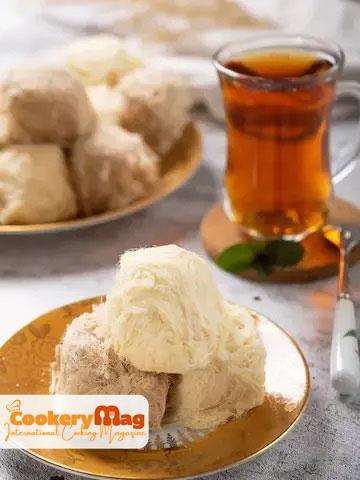
Thank you for being with us with this delicious and popular souvenir of yazd from Iran.
Pashmaks are produced in different flavors and colors. You can prepare this popular food at home or buy it in three forms: noodles, cupcakes form, and chocolate, from all supermarkets and grocery stores.
If you have any more questions, it’s my honor to answer. Enjoy your exploration of Persian cuisine! Please share this article with your friends on Facebook, Twitter, Pinterest, and other social media. 🧡


